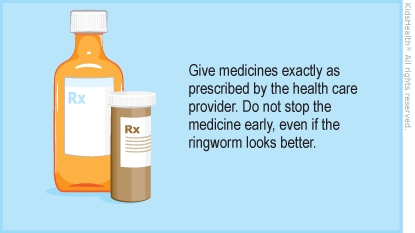Ringworm on the Scalp: How to Care for Your Child
Kids with ringworm on the scalp have one or more scaly patches. Ringworm is caused by a type of germ called a fungus. It usually goes away after taking a prescription medicine by mouth for several weeks. Hair loss often happens in the ringworm patches, but usually grows back after treatment.


-
Give medicines exactly as prescribed by the health care provider. Do not stop the medicine early, even if the patches look better, or the ringworm may come back.
-
If griseofulvin was prescribed, have your child take it with fatty food like ice cream, cheese, or peanut butter. This helps the medicine work better.
-
Your child can go to school after treatment has started.
-
To prevent the spread of scalp ringworm to others:
-
Help your child use an antifungal shampoo twice a week.
-
Teach your child to avoid sharing combs, brushes, hair accessories, pillows, hats, or helmets.
-
Machine wash your child's towels in hot, soapy water after each use.
-
Machine wash your child's sheets and pillowcases in hot, soapy water after treatment starts.
-
If your health care provider recommends it:
-
Have family members and pets checked for ringworm.
-
Have family members use an antifungal shampoo even if they don't seem to have ringworm. Some people can have the ringworm fungus without any signs of the infection. They may spread ringworm without even knowing it.
-
Schedule all follow-up visits and lab tests as instructed by your health care provider.

-
The ringworm doesn't start to get better in 7–10 days.
-
Your child gets a rash somewhere else on the body.
-
The infected skin looks redder or starts to ooze.
-
Your child has a headache or is vomiting.

How do you get ringworm? Most people with ringworm get it from touching a person or animal who has it. Someone can also get ringworm from a towel or brush, sports equipment, or a shower stall. Ringworm isn't caused by a worm, but the ring around the rash can look like one.
What is a kerion? A kerion is when swelling, irritation, and pus develop in the ringworm patch. It usually gets better with the medicine given for ringworm. Sometimes, another medicine is given to help reduce the swelling and irritation.
Can ringworm happen on other parts of the body? The fungus that causes ringworm is called tinea. There are different forms of tinea and they can cause a rash on different parts of the body. A tinea infection on the foot is called athlete's foot and in the groin area is called jock itch. Some people call all of these infections "ringworm."
How is ringworm diagnosed? Health care providers usually can diagnose ringworm by looking at it. Sometimes a bit of the scaly skin is sent to the lab to look for the fungus.
How can I prevent my child from getting ringworm again? To prevent all forms of ringworm, teach your child to:
-
Keep skin clean and dry.
-
Wash well with soap and shampoo after any sport that involves skin-to-skin contact.
-
Wear loose clothing and change socks and underwear at least once a day.
-
Avoid sharing clothing, sports equipment, towels, brushes, and other personal items.
-
Wear flip flops when walking in a shower stall, locker room, or pool area.